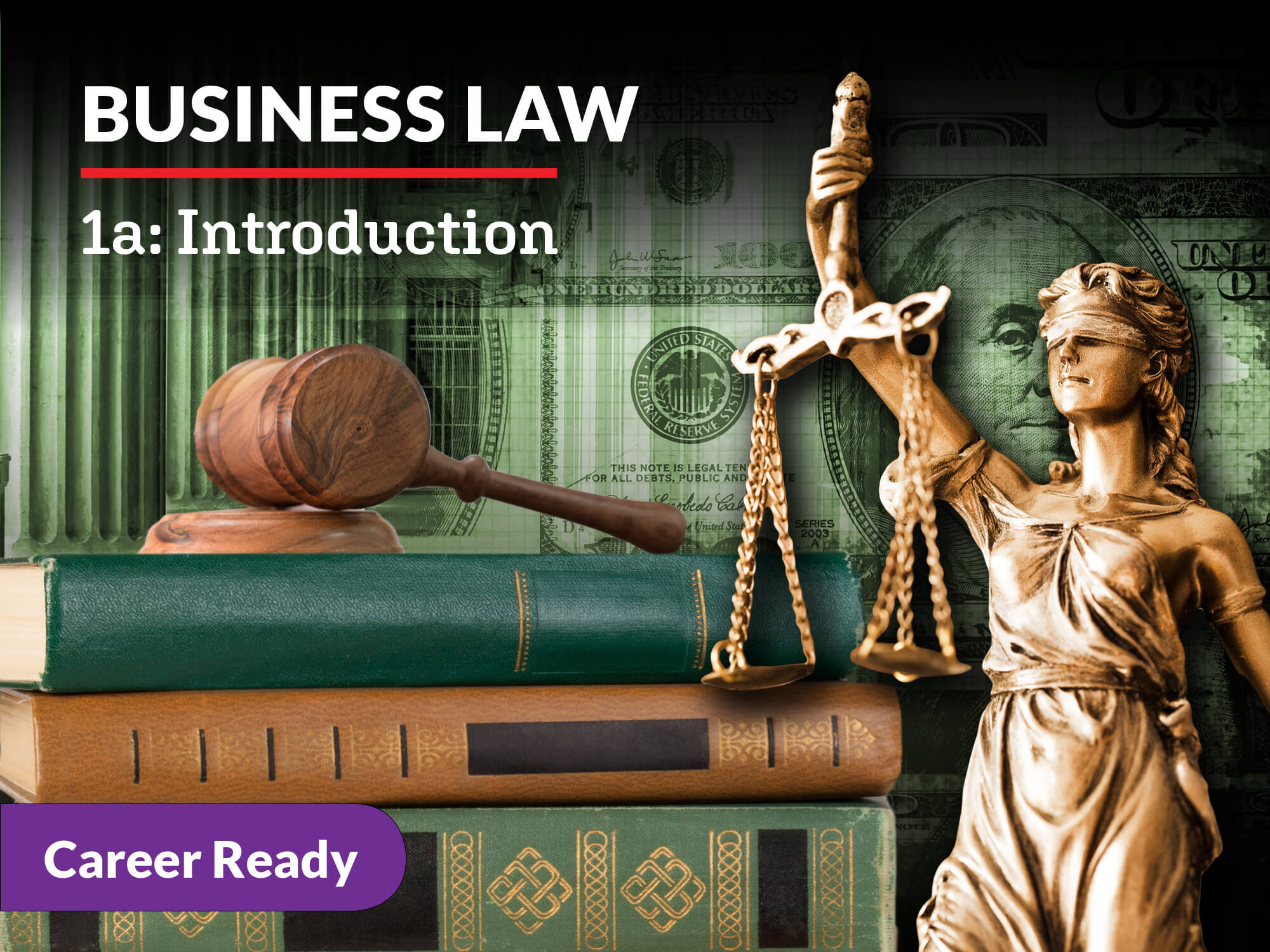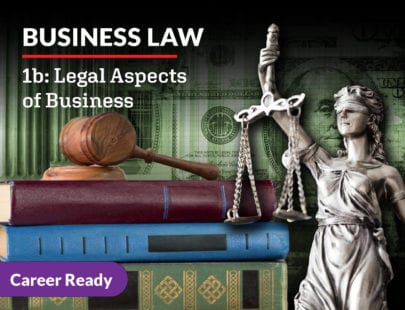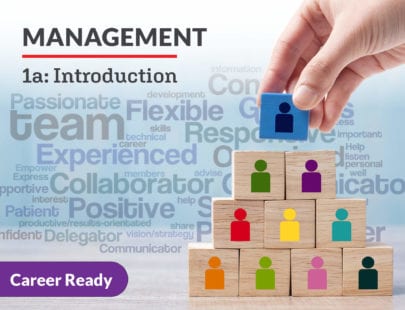
Business Law 1a: Introduction
Whether you plan on starting your own business or being in charge of one, it is crucial you understand how to keep the company compliant. Explore what it means to run an ethical business, how to keep intellectual property, technology, and e-commerce safe and protected, understand insurance and taxes, and how to have a healthy workplace environment. Keep the business safe and growing by following the law.
Units at a Glance
Unit 1: Ethics and Business
As we begin our study of business law, it is important to make a clear distinction between ethical and unethical, as well as legal and illegal, conduct. After all, not all unethical conduct is illegal—but that certainly does not make it acceptable! All companies are faced with ethical dilemmas at some point or another. These ethical dilemmas can arise in a range of situations and business relationships. Choosing the morally appropriate course of action is always best, even if another choice may be technically permissible under the law. Let’s see how some of our most visible companies face and resolve these types of issues.
What will you learn in this unit?
- Distinguish between ethical and legal behavior as well as unethical and illegal behavior
- Describe the tools a company uses to make ethical business decisions
- Examine case studies of corporations acting unethically
- Appreciate the regulations that govern lawyers’ ethical conduct in their relationship with clients
- Understand when public officials and lobbyists may or may not accept gifts or money from a company
Unit 2: Developing and Protecting Your Business
Intellectual property laws protect the rights of anyone who creates artistic works or designs. These different types of property rights apply to patents, trademarks, copyrights, and trade secrets. So what happens if you upload a video to YouTube that wasn’t created by you? Depending on how it’s used, you may owe lots of money to the owner of the video! So read on to learn more about intellectual property law and the potential penalties anyone who uses another’s intellectual property without first securing permission may face.
What will you learn in this unit?
- List the different types of patents and the steps to obtain a patent
- Distinguish between a trademark and service mark
- Describe copyright and the process for obtaining a copyright
- Compare the civil and criminal remedies for violations of intellectual property protections
- Critique the use of trade secrets and the use of confidentiality agreements
Unit 3: Getting a New Business Started
Have you ever wondered if it’s easy to start a business? Is it as simple as hanging out a sign, opening up the front door, and selling a product? In some cases, it can be that easy, especially if your customers are local, and you specialize in one or two products or services. But as the business grows, it can get a bit more complicated—at this point, a business owner may have to consider what the long-term goals are for the business. So, let’s look at the steps to organizing a business, and how a person who owns and operates a business decides what type of business to build.
What will you learn in this unit?
- List the key steps to building a strong strategic business plan
- Explain the advantages and disadvantages of a sole proprietorship
- Analyze the risks and benefits that come with general partnerships and limited partnerships
- Argue why starting a corporation may be preferable to entering into a partnership
- Identify hybrid business organizations
Unit 4: The Employer/Employee Relationship
As a business begins to grow, owners may not be able to handle all aspects of the company by themselves. In this case, an owner may consider whether they need or want to hire employees to help with the manufacturing and delivery of its products, or providing a service to its customers, especially if doing so makes it easier and more profitable to do business. Easy enough, right? Well, yes and no. If more people get involved in the company, the owners will have to spend more money for salaries and any benefits they offer their new employees. There will be a trade-off: is the company going to be more profitable by expanding even if it means paying employees, or is it better to stay small so the owner reaps all the benefit? In this unit, we explore different types of employees, their rights under the law, and the cost to employers who make the decision to hire employees. We will also examine the changing demographics of the workforce in today’s society.
What will you learn in this unit?
- Critique various types of employees and employer/employee relationships
- Understand what guidelines employers must follow to hire and retain employees
- Investigate current trends in employment and how the human resources department fosters a relationship between employees and employers
- Analyze characteristics of the changing workforce in today’s society
Unit 5: Workplace Behavior
Now that we’ve covered how employer–employee relationships are established, we will explore the day-to-day operations of a company—from both the employer’s and employees’ perspective. While it might seem that mutual respect should be enough to promote a safe and ethical working environment, companies attain greater success when they take the time to clearly, and repeatedly, train and mentor their employees in standard issues like company policies and anti-harassment measures, as well as exciting developments like new technologies.
What will you learn in this unit?
- Critique how successful businesses train employees to facilitate growth and anticipate pitfalls they may encounter
- Analyze how an effective boss or manager acts as a role model and leader among their employees
- List the expectations that companies, employers, and supervisors have for their employees
- Evaluate and explain the important role employers take in creating a safe work environment for their employees
Unit 6: Technology and eCommerce Best Practices
In the 21st century, businesses how found so many ways to use technology in the workplace. In fact, the role of technology is so important that many companies create a department in their organization to deal exclusively with technology. But using technology has both benefits, such as the convenience of online shopping, and risks, such as security concerns. Let’s dive in to explore how companies use technology, what they can do to maximize benefits while reducing risks, and the role of government in all of this.
What will you learn in this unit?
- List the key components of a technology plan, along with essential business hardware
- Determine the type of software applications that will improve the financial and collaborative well-being of a company
- Identify the strengths and weaknesses of a company’s online presence
- Recognize common cyber-crimes and how they impact a business
- Discuss issues involved in government oversight of the internet
Unit 7: Property and Insurance
As we know, the process of starting, running, and growing a business involves many layers of work. And once we’ve done the heavy lifting of getting a business up and running, hiring, and finding the best tech and security solutions, of course we are going to want to protect our assets. Suddenly it seems like the easiest part of operating a business is coming up with the idea for what you want to sell! So now, it’s time we explore the question, “What property belongs to my business, and how can I protect it?” Specifically, we’ll cover real and personal property, how property is transferred from one entity to another, and how the property should be insured.
What will you learn in this unit?
- Differentiate between real and personal property
- Understand how property rights are earned, transferred, and relinquished
- List the types of insurance coverage a business should purchase to protect its property
- Distinguish between insurance that a company must purchase to protect its employees and health insurance coverage, as well as major types of life insurance
Unit 8: Taxes
You know what they say: the only certainties in life are death and taxes. As we wrap up our journey, we will continue to explore the financial costs of doing business, and this, of course, includes paying taxes to the government. Most people who work and earn an income pay taxes on that income, but business owners have some unique opportunities and responsibilities when it comes to taxes.
What will you learn in this unit?
- Identify how tax requirements might differ depending on the organizational structure of a business
- Recognize how sales tax rates differ among varying localities and the impact these rates have on online sales
- Understand how governments use tax laws to regulate the business industry as well as consumer behavior
- Appreciate the obligation employers have to withhold income from employees in order to ensure compliance with federal and state law
Required Materials
Physical
- Video recording device or cell phone
- Audio recording device
Software
- Graphic design software (like Canva)
- Slide presentation software
- Word processing software



